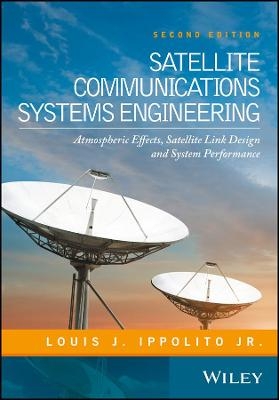
Satellite Communications Systems Engineering
John Wiley & Sons Inc (Verlag)
978-1-119-25937-4 (ISBN)
LOUIS J. IPPOLITO JR., Engineering Consultant and Adjunct Professor, The George Washington University, Washington DC, USA.
List of Acronyms xiii
Preface to Second Edition xix
1 Introduction to Satellite Communications 1
1.1 Early History of Satellite Communications 3
1.1.1 SCORE 3
1.1.2 ECHO 3
1.1.3 COURIER 4
1.1.4 WESTFORD 4
1.1.5 TELSTAR 4
1.1.6 RELAY 4
1.1.7 SYNCOM 5
1.1.8 EARLYBIRD 5
1.1.9 APPLICATIONS TECHNOLOGY SATELLITE-1, ATS-1 5
1.1.10 ATS-3 5
1.1.11 ATS-5 6
1.1.12 ANIK A 6
1.1.13 ATS-6 6
1.1.14 CTS 8
1.2 Some Basic Communications Satellite System Definitions 9
1.2.1 Satellite Communications Segments 9
1.2.2 Satellite Link Parameters 10
1.2.3 Satellite Orbits 11
1.2.4 Frequency Band Designations 13
1.3 Overview of Book Structure and Topics 13
References 15
2 Satellite Orbits 17
2.1 Kepler’s Laws 18
2.2 Orbital Parameters 19
2.3 Orbits in Common Use 22
2.3.1 Geostationary Orbit 23
2.3.2 Low Earth Orbit 25
2.3.3 Medium Earth Orbit 26
2.3.4 Highly Elliptical Orbit 26
2.3.5 Polar Orbit 27
2.4 Geometry of GSO Links 27
2.4.1 Range to Satellite 29
2.4.2 Elevation Angle to Satellite 29
2.4.3 Azimuth Angle to Satellite 30
2.4.4 Sample Calculation 31
References 33
Problems 33
3 Satellite Subsystems 35
3.1 Satellite Bus 36
3.1.1 Physical Structure 37
3.1.2 Power Subsystem 38
3.1.3 Attitude Control 39
3.1.4 Orbital Control 39
3.1.5 Thermal Control 41
3.1.6 Electronic Propulsion Satellites 42
3.1.7 Tracking, Telemetry, Command, and Monitoring 43
3.2 Satellite Payload 45
3.2.1 Transponder 45
3.2.2 Antennas 47
References 48
4 The RF Link 49
4.1 Transmission Fundamentals 49
4.1.1 Effective Isotropic Radiated Power 51
4.1.2 Power Flux Density 51
4.1.3 Antenna Gain 52
4.1.4 Free-Space Path Loss 55
4.1.5 Basic Link Equation for Received Power 56
4.2 System Noise 59
4.2.1 Noise Figure 61
4.2.2 Noise Temperature 63
4.2.3 System Noise Temperature 66
4.2.4 Figure of Merit 69
4.3 Link Performance Parameters 70
4.3.1 Carrier-to-Noise Ratio 70
4.3.2 Carrier-to-Noise Density 72
4.3.3 Energy-per-Bit to Noise Density 72
Reference 73
Problems 73
5 Link System Performance 75
5.1 Link Considerations 75
5.1.1 Fixed Antenna Size Link 76
5.1.2 Fixed Antenna Gain Link 77
5.1.3 Fixed Antenna Gain, Fixed Antenna Size Link 77
5.2 Uplink 79
5.2.1 Multiple Carrier Operation 81
5.3 Downlink 81
5.4 Percent of Time Performance Specifications 82
References 84
Problems 85
6 Transmission Impairments 87
6.1 Radiowave Frequency and Space Communications 87
6.2 Radiowave Propagation Mechanisms 89
6.2.1 Absorption 90
6.2.2 Scattering 90
6.2.3 Refraction 90
6.2.4 Diffraction 90
6.2.5 Multipath 90
6.2.6 Scintillation 90
6.2.7 Fading 90
6.2.8 Frequency Dispersion 90
6.3 Propagation Below About 3 GHz 92
6.3.1 Ionospheric Scintillation 95
6.3.2 Polarization Rotation 97
6.3.3 Group Delay 98
6.3.4 Dispersion 99
6.4 Propagation Above About 3 GHz 100
6.4.1 Rain Attenuation 101
6.4.2 Gaseous Attenuation 105
6.4.3 Cloud and Fog Attenuation 107
6.4.4 Depolarization 108
6.4.5 Tropospheric Scintillation 114
6.5 Radio Noise 117
6.5.1 Specification of Radio Noise 119
6.5.2 Noise From Atmospheric Gases 121
6.5.3 Sky Noise Due To Rain 124
6.5.4 Sky Noise Due to Clouds 125
6.5.5 Noise From Extra-Terrestrial Sources 126
References 134
Problems 135
7 Propagation Effects Modeling and Prediction 138
7.1 Atmospheric Gases 138
7.1.1 Leibe Complex Refractivity Model 139
7.1.2 ITU-R Gaseous Attenuation Models 140
7.2 Clouds and Fog 152
7.2.1 ITU-R Cloud Attenuation Model 153
7.2.2 Slobin Cloud Model 155
7.3 Rain Attenuation 162
7.3.1 ITU-R Rain Attenuation Model 162
7.3.2 Crane Rain Attenuation Models 176
7.4 Depolarization 187
7.4.1 Rain Depolarization Modeling 188
7.4.2 Ice Depolarization Modeling 190
7.5 Tropospheric Scintillation 194
7.5.1 Karasawa Scintillation Model 194
7.5.2 ITU-R Scintillation Model 197
7.5.3 van de Camp Cloud Scintillation Model 199
References 201
Problems 203
8 Rain Fade Mitigation 205
8.1 Power Restoral Techniques 205
8.1.1 Beam Diversity 206
8.1.2 Power Control 207
8.1.3 Site Diversity 211
8.1.4 Orbit Diversity 227
8.2 Signal Modification Restoral Techniques 229
8.2.1 Frequency Diversity 230
8.2.2 Bandwidth Reduction 231
8.2.3 Time-Delayed Transmission Diversity 231
8.2.4 Adaptive Coding and Modulation 231
8.3 Summary 232
References 232
Problems 233
9 The Composite Link 235
9.1 Frequency Translation (FT) Satellite 236
9.1.1 Uplink 236
9.1.2 Downlink 238
9.1.3 Composite Carrier-to-Noise Ratio 238
9.1.4 Performance Implications 243
9.1.5 Path Losses and Link Performance 244
9.2 On-Board Processing (OBP) Satellite 248
9.2.1 OBP Uplink and Downlink 250
9.2.2 Composite OBP Performance 250
9.3 Comparison of FT and OBP Performance 252
9.4 Intermodulation Noise 255
9.5 Link Design Summary 257
References 258
Problems 258
10 Satellite Communications Signal Processing 261
10.1 Analog Systems 261
10.1.1 Analog Baseband Formatting 262
10.1.2 Analog Source Combining 264
10.1.3 Analog Modulation 264
10.2 Digital Baseband Formatting 270
10.2.1 PCM Bandwidth Requirements 273
10.2.2 Nearly Instantaneous Companding (NIC) 273
10.2.3 Adaptive Delta Modulation (ADM) or Continuously Variable Slope Delta Modulation (CVSD) 273
10.2.4 Adaptive Differential PCM (ADPCM) 274
10.3 Digital Source Combining 274
10.4 Digital Carrier Modulation 275
10.4.1 Binary Phase Shift Keying 278
10.4.2 Quadrature Phase Shift Keying 280
10.4.3 Higher Order Phase Modulation 283
10.5 Summary 283
Reference 284
Problems 284
11 Satellite Multiple Access 286
11.1 Frequency Division Multiple Access 289
11.1.1 PCM/TDM/PSK/FDMA 290
11.1.2 PCM/SCPC/PSK/FDMA 292
11.2 Time Division Multiple Access 293
11.2.1 PCM/TDM/PSK/TDMA 294
11.2.2 TDMA Frame Efficiency 295
11.2.3 TDMA Capacity 296
11.2.4 Satellite Switched TDMA 299
11.3 Code Division Multiple Access 303
11.3.1 Direct Sequence Spread Spectrum 306
11.3.2 Frequency Hopping Spread Spectrum 309
11.3.3 CDMA Processing Gain 310
11.3.4 CDMA Capacity 312
References 314
Problems 314
12 The Mobile Satellite Channel 316
12.1 Mobile Channel Propagation 316
12.1.1 Reflection 317
12.1.2 Diffraction 318
12.1.3 Scattering 318
12.2 Narrowband Channel 321
12.2.1 Path Loss Factor 323
12.2.2 Shadow Fading 327
12.2.3 Multipath Fading 333
12.2.4 Blockage 340
12.2.5 Mixed Propagation Conditions 346
12.3 Wideband Channel 348
12.4 Multi-Satellite Mobile Links 351
12.4.1 Uncorrelated Fading 351
12.4.2 Correlated Fading 353
References 355
13 Spectrum Management in Satellite Communications 357
13.1 Spectrum Management Functions and Activities 357
13.1.1 International Spectrum Management 358
13.1.2 World Radiocommunication Conference (WRC) 361
13.1.3 Frequency Allocation Process 361
13.1.4 Spectrum Management in the United States 365
13.2 Methods of Radio Spectrum Sharing 368
13.2.1 Frequency Separation 369
13.2.2 Spatial Separation 371
13.2.3 Time Separation 372
13.2.4 Signal Separation 372
13.3 Spectrum Efficiency Metrics 372
13.3.1 Spectrum Utilization Factor (U) 373
13.3.2 Spectrum Utilization Efficiency (SUE) 373
References 374
Problems 374
14 Interference Mitigation in Satellite Communications 376
14.1 Interference Designations 376
14.2 Modes of Interference for Satellite Services Networks 377
14.2.1 Interference Between Space and Terrestrial Services Systems 377
14.2.2 Interference Between Space Services Networks 378
14.2.3 Interference Between Space Services Networks with Reverse Band Allocations 379
14.3 Interference Propagation Mechanisms 379
14.3.1 Line-of-Sight Interference 381
14.3.2 Diffraction 382
14.3.3 Tropospheric Scatter 383
14.3.4 Surface Ducting and Layer Reflection 383
14.3.5 Hydrometeor (Rain) Scatter 384
14.4 Interference and the RF Link 386
14.4.1 Single Interferer (pfd) 387
14.4.2 Multiple Interferers (epfd) 387
14.5 Coordination for Interference Mitigation 388
14.5.1 Radio-Climate Zones 390
14.5.2 Distance Limits 391
14.5.3 Coordination Distance for Mode (1) Propagation 392
14.5.4 Coordination Distance for Mode (2) Propagation 393
14.5.5 ITU-R Coordination Procedures for Satellite and Terrestrial Services 394
References 395
Problems 396
15 High Throughput Satellites 398
15.1 Evolution of Satellite Broadband 399
15.2 Multiple Beam Antennas and Frequency Reuse 401
15.2.1 Multiple Beam Antenna Array Design 402
15.2.2 Adjacent Beam SIR 406
15.3 HTS Ground Systems Infrastructure 412
15.3.1 Network Architectures 412
15.3.2 Frequency Band Options 413
15.4 Satellite HTS and 5G 416
15.4.1 Cellular Mobile Technology Development 416
15.4.2 Satellite 5G Technologies 418
References 422
Appendix Error Functions and Bit Error Rate 423
A.1 Error Functions 423
A.2 Approximation for BER 425
Index 427
| Erscheinungsdatum | 28.04.2017 |
|---|---|
| Verlagsort | New York |
| Sprache | englisch |
| Maße | 178 x 246 mm |
| Gewicht | 839 g |
| Themenwelt | Technik ► Elektrotechnik / Energietechnik |
| ISBN-10 | 1-119-25937-1 / 1119259371 |
| ISBN-13 | 978-1-119-25937-4 / 9781119259374 |
| Zustand | Neuware |
| Informationen gemäß Produktsicherheitsverordnung (GPSR) | |
| Haben Sie eine Frage zum Produkt? |
aus dem Bereich


